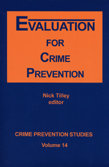
Edited by Nick Tilly
This paper examines how displacement and diffusion of benefits can be measured within the context of crime reduction project evaluations. Attempts to monitor the impact of Reducing Burglary Initiative (RBI) projects in the United Kingdom
highlighted an existing lack of measurement strategies in this area. This paper seeks to make a start at addressing this problem through a three-stage approach. First, this paper examines existing empirical and theoretical literature on displacement and diffusion of benefits and highlights some of the established difficulties associated with their measurement. It is argued that many of these difficulties relate to the lack of a systematic basis for targeting measurement. Second, the paper reviews some of the key literature on offender decision making, motivation and mobility to see if there is any empirical basis for anticipating the direction and form of any displacement/diffusion of benefits. Third, this paper goes on to explore how one might, within the context of typical project evaluation research, model offending characteristics with the aim of anticipating any possible offender adaptation to the impact(s) of project work. This is illustrated with the example of the "buffer zone selection model," which was developed to select areas to test for spatial displacement/diffusion of benefits from RBI project areas. The discussion then turns to examining how one might interpret changes in crime levels in project and buffer areas, and a number of possible confirmatory tests are outlined that could be utilised to validate any resulting hypotheses.
Research on cost-benefit analysis of situational crime prevention is examined and found wanting. The few existing studies do not accurately represent the likely benefits of the situational approach. While measures of non-monetary crime costs are improving, at least four other key areas warrant more attention: First, "routine savings" derive from routine precautions. Second, models of victim (producer) and offender (consumer) surplus are underdeveloped in this field. Third, crime externalities occur when entities (such as manufacturers, premises managers, some persons and environments) produce targets and situations that provide criminal opportunities. These entities "externalize" or do not bear the crime costs to society that they produce. We propose the concept of "crime as pollution" for the study of crime externalities, and outline the potential of policies adapted from environmental economics. Fourth, the intentional absence of crime prevention has an opportunity cost that might be examined as a form of negligent omission.
Increasing attention is being paid to the systematic review and synthesis of evaluations of large-scale, generic, crime prevention programs. The utility of these syntheses rests on the assumption that the programs are designed to work across a wide variety of contexts. But many police problem-solving efforts and situational prevention interventions are small-scale efforts specifically tailored to individual contexts. Do evaluation designs and methods applicable to generic programs apply to problem specific programs? Answering this questions requires examining the differences between propensity-based and opportunity-blocking interventions; between internal and external validity; and between the needs of practitioner evaluators and! academic researchers. This paper demonstrates: that in some common circumstances, weak evaluation designs may have greater utility and produce more generalizable results than very strong evaluation designs. This conclusion has important implications for evaluations of place-based opportunity blocking, and for how we draw general conclusions about what works when, and what seldom works.
Community crime prevention programs are used to reduce the incidence of crime in communities and encourage community participation in crime prevention. The evaluation of a community crime prevention program can provide valuable information about the program's appropriateness, acceptability to key stakeholders, efficacy and efficiency, thereby enabling managers to plan improvements. In Australia , however, relatively few programs are evaluated. Where evaluation studies have been undertaken, they have used a narrow range of evaluation models, often focusing solely on measuring project outcomes or impact.
Inter-organizational partnerships are widely praised as a vehicle for planning and implementing complex, comprehensive community interventions. This article explores conceptual, design, and measurement issues relevant to the evaluation of coalitions, with particular reference to anti-crime initiatives. A general theory of partnerships is outlined that goes beyond organizational models to focus on the complexity of intervention strategies: domains of influence, causal mechanisms, intervention targets, and partnership services. To fill a large gap in our knowledge of coalition effectiveness, impact evaluations should include a mixture of strong research designs with counterfactuals, a theory (or multiple theories) of change, a blend of quantitative and qualitative methods, measurement and analysis at multiple levels, and multiple case studies for understanding the dynamics and external relationships of each partnership. The primary substantive issue for public safety partnerships is the failure to be inclusive, thus undermining their greatest strength. Finding the proper role for 'the community" has been a continuous challenge as law enforcement agencies and strategies tend to be overrepresented.